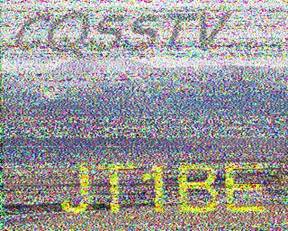|
SLOW SCAN TELEVISION
Brief
overview of modern SSTV (Slow Scan TeleVision) techniques.
Published in the WANSAC (Western
& Northern Suburbs Amateur Radio Club) monthly club magazine Vol 38 Issue
May 2007
http://www.wansarc.org.au/
SLOW SCAN TELEVISION by Peter Miles
According to my copy of the ARRL Handbook 1990, Slow Scan Television
(SSTV) originated in 1958 through the collaborative efforts of a team of Amateur operators led by Copthorne
Macdonld, VE1BFL. Their goal was to transmit television pictures over HF radio circuits. The resulting system allowed for the transmission of a single television frame of 120 lines within the 3kHz voice frequency range commonly associated with HF phone operations.
Initially, SSTV was a complex and technically involved process that utilized long persistence cathode ray tubes and related electronics to decode and display crude black and white trace images. I first witnessed a demonstration of Slow Scan Television in 1978, which aimed to showcase the transmission of color images by transmitting a series of scans through color filters and photographically recovering the image through multiple film exposures. While it worked and left a strong impression on me, I realized that this approach was more suitable for dedicated SSTV enthusiasts and photographers.
Since those early days, significant advancements have been made, and most SSTV transmission and reception now rely on computer software for generating and decoding, resulting in highly acceptable
colour images. The primary objective of SSTV remains unchanged: to transmit and receive a single television frame over a voice channel within the bandwidth constraints of the band and mode in use. In a typical HF single sideband channel, which allows approximately 2.5kHz of bandwidth, it takes about a minute to build up the SSTV picture line by line.
There are several modes of SSTV transmission, but the two most popular ones among operators are Scottie-1 and Martin-1. Scottie-1 enjoys popularity in Australia, Japan, and the United States, while Martin-1 is more
favoured by European operators.
Various SSTV software packages are available, many of which are of excellent quality. Personally, I prefer
MMSSTV, partly because it is free, but mainly because it offers an impressive range of features and is user-friendly. MMSSTV runs comfortably on relatively older computers, such as the 133MHz Pentium under Windows 95.
MMSSTV Version 1.11, produced by Makoto Mori JE3HHT, can be downloaded from MM Hamsoft at
http://mmhamsoft.amateur-radio.ca/. A quick internet search will provide a wealth of
SSTV-related information and programs. While many hams passionately recommend MSCAN SSTV V2.2 or other available programs, MMSSTV remains my personal
favourite.

See screen dump of
MMSSTV with image loaded and ready for transmission.
Interface:
The interface between the radio equipment and the computer is straightforward. The audio output and input from the radio can be directly plugged into the relevant input and output of the computer's sound card. While many operators have had success with the hard connection method, I have chosen to use isolation transformers to ensure that stray RF cannot find its way into unwanted areas through ground loops.
Feeding the signal into the microphone socket of the transceiver will require substantial attenuation of the
SSTV-generated signal to prevent overdriving the transmitter. This can be achieved by feeding the signal via a simple resistor network and fine-tuning with the transceiver's mic gain while monitoring the RF power level.
A search on the internet will yield a wide range of circuits to achieve the interface between the computer sound card and the transceiver. Additionally, there are several commercial interfaces available for this task. The critical interface issue to watch for when transmitting is overdriving the transmitter, which can result in a lot of adjacent channel interference and possibly damage to the transmitter.
Duty Cycle:
The SSTV-generated signal is a frequency-modulated tone that causes the transmitter to work hard. Therefore, it is recommended to reduce the transmit power to around twenty watts for the average 100W HF SSB transceiver or to about the AM rating of the transceiver. The duty cycle should not be an issue for typical VHF/UHF FM transceivers.
SSTV Frequencies:
The official Australian WIA band plan designates several Slow Scan Television call channels. To my knowledge, there are no official designations below the 20-meter band, although I have occasionally monitored SSTV activity on 3.698MHz and 7.040 MHz. SSTV is particularly susceptible to noise, so pictures on the 40 and 80-meter bands would likely be fairly degraded unless the band is exceptionally quiet or signals are very strong. SSTV can be enjoyed on 2 meters FM, where even moderate signal strengths produce high-quality pictures.
A feature of MMSSTV is its ability to automatically store up to 32 received images. I have found it interesting to leave MMSSTV and the radio running overnight on 14.230MHz and check the next morning to see which parts of the world were open during that period.
WIA Band Plan for SSTV activity:
14.230MHz: SSTV International calling frequency (Very active)
14.233MHz: SSTV (Also active)
21.340MHz: SSTV International calling frequency
28.680MHz: SSTV International calling frequency
145.625MHz: SSTV (Can be active)
The Future:
SSTV has evolved from being an expensive and technically demanding experimental fringe activity to a low-cost and technically accessible mode for all amateur operators. It is interesting to note that this transformation has largely occurred in the last ten years, with the development of High Definition Slow Scan Television
(HDSSTV) and Digital Slow Scan Television, which focuses more on file transfer. These advancements are becoming more mainstream, indicating a bright and evolving future for transmitting pictures over HF radio circuits.
I'm far from a dedicated SSTVer; I simply dabble. But if you have any questions about
SSTV, please do not hesitate in contacting me!
|

|

|
|
A weak signal on 14.23MHz SSB |
A solid signal on 145.625MHz FM
|
Also
see related pages:
Computer
to Radio Soundcard Interface Computer
Sound-card Interface for TS-430S
For more information on
sound card interfacing. See:
http://www.qsl.net/wm2u/interface.html
TOP
OF PAGE
Page initiated May, 2007
Page
last revised
05 November, 2025
|